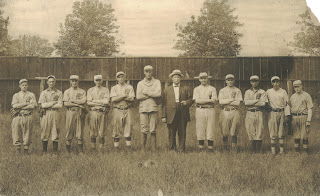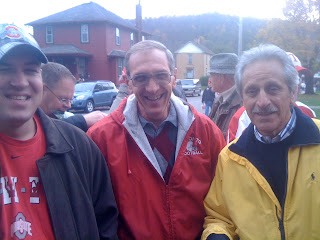 |
| 1911 Toronto Athletic Club, John Petras third from left |
My grandfather played first base and sometimes second and batted cleanup for the town of 4000 residents. I just remember bits and little chunks of his stories, but these odds and ends of this patchwork memory stick out like a seam in time.
My grandfather played during the Dead Ball Era; so home runs were hard to come by, even on some fenceless fields that sometimes resembled more pasture than stadium. He did tell me he hit a pitch at the old Kaul Field that landed on a fly beyond the Pennsylvania Railroad tracks, 400 and some odd feet in all. Pappap wasn't a big man, standing 5-8 and weighing perhaps 150 pounds, and a pound of that was probably chaw tobacco. But he had wrists and forearms as sinewy as cable steel, developed from working the sewer pipe factory since he was 12 years old, when he had to support his family of seven because his father, Joseph Petras, had become infected with tuberculosis.
I grew up in the 60s, my favorite players being Roberto Clemente, Bill Mazeroski and Mickey Mantle. My grandfather always complained that the modern ball players were prima donnas, that they never played hurt like the old-timers did. Maybe he held such sentiments because he took a high hard one that left his nose disfigured for life. The dead ball was not so dead, after all.
My grandfather also played when the spitball was still legal, and besides taking an occasional high hard one to the kisser, a batter also got an occasional shot of Mailpouch squeezins right between the eyes.
Pappap would tell me about trick plays the semi-pros would pull off once in a while, like one time a pitcher was attempting to pick off a runner on first base and he threw an errant pick-offf attempt down the right field foul line. Turned out that errant toss was a potato and they nabbed the runner between first and second with the real ball.
I was in my Biltmore Avenue backyard, pretending I was Whitey Ford, when suddenly out of the visitor's dugout via back porch next door appeared Fred Maple. "Your grandfather was the greatest ballplayer from Toronto I have ever seen," Mr. Maple said. I don't know exactly why he told me this, maybe because I was throwing rocks into his backyard. After he told me this, I never threw rocks into his yard again.
My grandfather, despite dropping out of school at such an early age, could speak several languages, including Slovak, Polish and German, and occasionally served as an interpreter in the trenches of Belgium and France during World War I. He told me only the humorous anecdotes about capers he and his chums pulled off upon the officers, never about the horrors of the trenches. But of all his tales of Army life and sports, the one I remember most is about the time the little town of Toronto, Ohio took on the mighty Pittsburgh Pirates.
Back in the Dead Ball Era, the major league's regular season ended late September. The players, by no means, earned the exorbitant salaries today's prima donnas do. After the regular season, the Dead Ball Era players would supplement their incomes by returning home to farm or factory or by barnstorming against local nines. The Pirates were one such team that regularly vied against semi-pro teams from Western Pennsylvania, and Ohio teams such as East Liverpool, Steubenville and Toronto.
I remember one Sunday afternoon. My grandfather was sitting upon his threadbare red recliner, his hands clasped behind his neck, a plug of Union Workman bulging from his cheek. My grandmother's house smelled of rhubarb pie, Neapolitan ice cream, cabbage rolls, Pinesol and Lemon Glade when suddenly I was smelling the coal soot from the kilns and giant smoke stack from the old wooden stadium across the tracks of parent company Kaul Clay.
The Pittsburgh Pirates came to town, hopped right off the train behind left field. The Toronto Athletic Club had beaten their rivals East Liverpool and Steubenville and now had a star player on its squad to make this contest against the major league club more interesting. Alva "Pick" Nalley was back on the Toronto nine. Nalley had just returned from a stint on the Toledo Mud Hens and was looking to have a good showing against a Big League club to show he belonged.
 |
| The legendary Honus Wagner would go on to play for the Toronto Athletic Club in 1919 under manager Bill McKechnie, another future Hall of Famer, who took up residency in the Gem City. |
I don't remember the details about the game, just those about the bat and that Toronto won. I suspect my grandfather must have made the bat himself. He and Honus Wagner rapped out a few hits apiece with this wonder bat that predated the real Hollywood Wonder Bat. I don't know what happened to this bat, or maybe I was afraid to ask, to know like all things forgotten forever.
Pick Nalley never did reach the big leagues, but he did play 13 years in the minors. Throwing right, batting left, Nalley rapped out 1429 hits during his minor league career. After baseball, he worked as a longtime custodian for Toronto City schools.
My dad once told me my his father was a little too slow a runner to play in the majors during an era when the main strategy relied upon stolen bases, the hit-and-run and bunting--small ball, they still call it. The Dead Ball Era unofficially ended1919 when Babe Ruth hit a Major League record 29 home runs, the year after the Great War ended. At 29, my grandfather was too old to be considered a prospect, and, besides, after taking that high hard one to the snoz, my dad also revealed, Pappap was never the same player again.
1913 Toronto Athletic Club. John Petras standing third to left, Pick Nalley kneeling in uniform.
After the Kaul Clay riots of 1935, my grandfather became custodian at St, Francis Church. My favorite story of his janitor days was when he learned World War II had officially ended and then sprinted from his Loretto Avenue home down the church to St. Francis to ring its massive bell, joining the resounding peels from all the steeples in town. The bronze peels must have been the most melodious sounds ever heard in the Gem City.
The only rocks I throw nowadays are the stones I skip across the ponds of time; they ripple with memories, memories I like to share with five grandchildren, with another grandchild on the way, memories when I, like them, was a child, memories ever green, ever-sweet and wild-eyed, memories of memories.
See related stories: "The Kaul Clay Riots of 1935," and "Kaul Field Revisited."





















